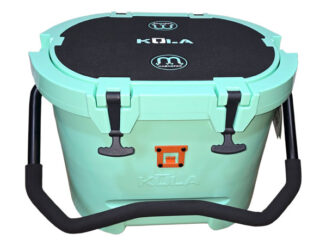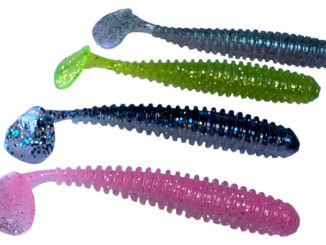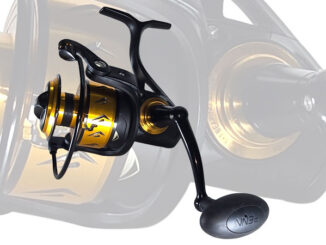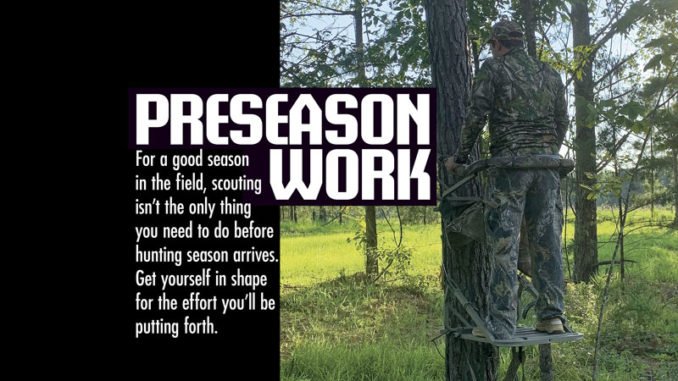
Those of us who hunt and recreate in the great outdoors will soon be climbing trees, pulling bow strings, carrying knapsacks and rifles and hiking up and down hill and dale.
If you are not already in “hunting shape,” it is not too late to start exercising and training. Just remember, the most-important way to get in shape is to identify your goals and tailor your training to achieve them. For best results, the goals you set need to be relevant to your particular outdoor interests.
Not only will getting yourself in proper shape make you a better, happier and probably more successful hunter, regular physical activity can produce long-term health benefits. Regular exercise and resulting physical fitness helps provide stronger bones and muscles and increases a person’s overall energy level. It’s important to start slowly and set small achievable goals. It is safer this way and will set you up for success.
It is a serious matter
We all hear stories or have personal experience with hunters hurting themselves or even dying while in the pursuit of game. Many of these injuries and deaths could have easily been prevented with some preseason preparation. Preparing physically is every bit as essential as planning where to put tree stands and sighting in your bow. Some accidents are inevitable, but often, hunters are just not physically prepared for what is — and let’s not kid ourselves — an activity that can be brutally physical at times. Most of us grew up hunting and enjoying the outdoors, but the vitality of youth all too soon transitions to middle age and then to old age. There is absolutely no reason to slow down or curtail your hunting passion as you age.
Yes indeed, what we are talking about here can be challenging and take some time out of your week, but it will pay off long-term. So, if you are not already exercising regularly, be sure and talk to your family physician before beginning an exercise program.
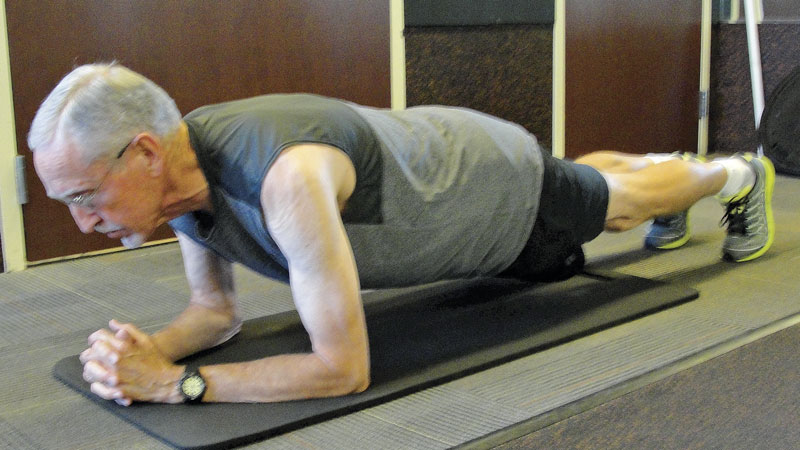
Professional advice
To get the best advice on just what to do and not do, I consulted a friend, Travis Twilbeck, who has degrees, training, and experience in Exercise Science and Sports Medicine. He helped set up my personal training regimen, which I do for about two hours at least three times per week. It has worked wonders for me physically and overall health-wise. At 71, I can still do most everything outdoors that I ever did as a younger person, because I have been regularly exercising and lifting weights for many years. Regrettably, as people age, they actually need to speed up and intensify their efforts to maintain physical capabilities, but most people tend to slow down and become more sedentary. This is a recipe for disaster when it comes to general health and to the physical abilities necessary to safely and successfully hunt and recreate in the outdoors.
The breakdown
Twilbeck breaks down getting properly fit to hunt into four areas of emphasis: endurance, core strength, flexibility and diet — the four pillars of fitness. For an exercise program to promote “functional fitness”, it needs to replicate real-world activity. There is a definite difference between working out to get in “beach shape” and working out to get in “hunting shape.” Getting in beach shape is more about appearance, while getting in hunting shape is all about function and overall condition to achieve better performance in the field. I am far from a bodybuilder, but even at my age, I can still safely climb tree-stand ladders and scale trees. It is all because of my year-round adherence to Twilbeck’s four pillars of fitness.
Endurance
To create or increase stamina and endurance, start moving. It can be as simple as walking or jogging around your neighborhood. You can go for a hike or climb up flights of stairs carrying a weighted rucksack or belt-pack. You can ride a bicycle or go to a gym and walk or jog on a treadmill.
Core strength
When you are hiking from your vehicle or ATV to your hunting spot, you will be carrying all sorts of gear and often wearing heavy clothing and boots. The weight you are carrying over and above your body weight adds up fast when you factor in a rifle or shotgun with ammunition that will alone easily weigh 10 to 15 pounds. For bowhunters, drawing a bow with a proper draw weight for hunting requires upper body strength.
Then, if your hunt is successful, you will be pulling or carrying the weight of a dead animal back to your vehicle or ATV. Core strength training is a vital part of getting fit for hunting.
Flexibility
Stretching to become more flexible goes hand-in-hand with strength training. While hunting, you will be stepping on and off of logs, stumps and rocks, all while humping up and down hills and hollows. You cannot do this safely without core strength, flexibility and balance.
Diet
Diet and exercise are key components of getting in shape. According to some experts, a general rule-of-thumb is that if weight loss is one goal of a getting-fit plan, 75% of your effort should be diet and 25% should be exercise. Also, alcohol consumption, especially the night before a hunt, can be a safety problem as well as cause dehydration, which can seriously reduce a hunter’s physical performance.
Strength vs. Endurance
Experts recommend:
- For cardiovascular (endurance) training, you should exercise at least 30 minutes per session, five or more days a week.
- Strength training should be performed two to three days a week with an emphasis on core and functional exercises.
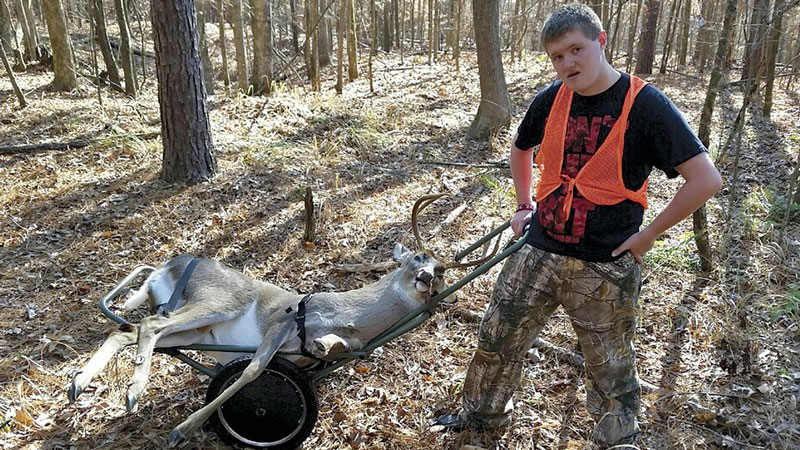
Cardio training is important
Cardio exercises to improve your stamina and endurance can include:
- Hiking with a weighted pack to simulate field conditions.
- Biking on a stationary or regular bicycle.
- Walking: use sidewalks and paths, especially ones with hills.
- Jogging: if your knees are up to it, this is the old standby.
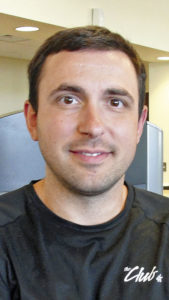
An exercised life
Travis Twilbeck grew up in Paris, TN, where he began his love of sports and fitness while playing multiple sports in high school. He went on the receive a bachelor’s degree in Kinesiology and Exercise Science from Mississippi College, where he also worked on the athletic training staff. He has since continued to gain knowledge in the field and obtained a master’s degree in Exercise Science, conducting research and specializing in cancer exercise therapy. He is a certified exercise physiologist through the American College of Sports Medicine and holds credentials in Exercise is Medicine.
Core work expands the base
As we age, most of us tend to neglect core strength training. Consider doing the following:
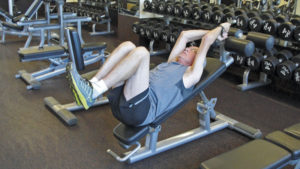
- Carry heavy objects or wear a weighted rucksack up and down hills and inclines.
- Use an elastic band to increase muscular strength.
- Attach a rope to an old truck tire and drag, pull or flip it to simulate field conditions.
- Use free weights and resistance-machine training at a gym. To build muscle endurance, use lower weights and more repetitions.
You are what you eat
A good healthy diet should be based on:
- Eating lean protein and avoiding processed meats.
- Eating lots of vegetables and fruit.
- Cutting back on foods containing refined sugar.
- Drinking plenty of water. A minimum of 64 ounces (1/2 gallon) of water per day is recommended for proper body function.
